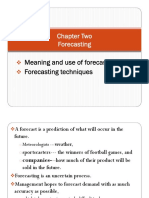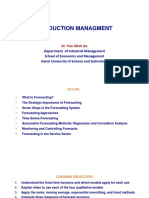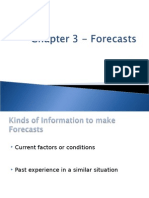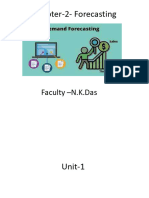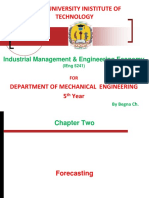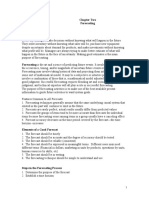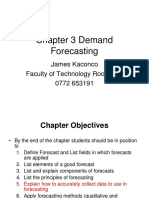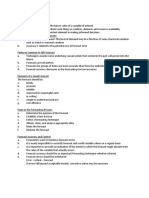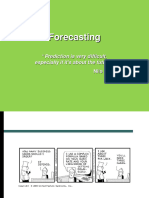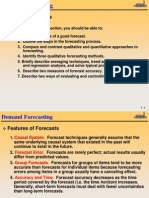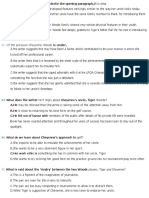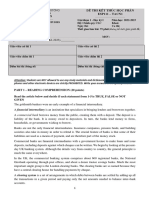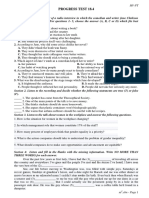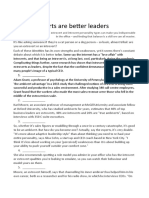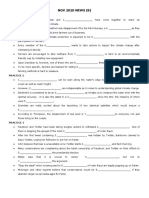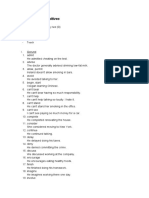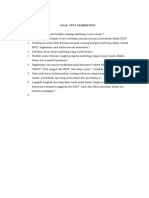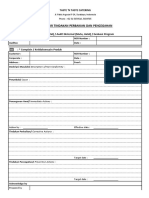30/10/2024
MODULE
SUPPLY CHAIN MANAGEMENT
CHAPTER 2: DEMAND FORECASTING
Lecturer: Assoc. Prof. Dr Nguyen Thi Binh
Department of Logistics and Supply Chain Management
Foreign Trade University
Tel: 036 977 03307
Email: ntbinh@ftu.edu.vn
CONTENTS
1. Role of demand forecasting in a supply chain
2. Qualitative forecasting techniques
3. Quantitative forecasting techniqies
1
� 30/10/2024
1. ROLE OF DEMAND FORECASTING IN A SC
▪ The nature of SCM
Supply Demand
SCM: Demand-Supply Balancing
How to balance demand-supply in a
supply chain management?
▪ Hold plenty of stocks ▪ Use flexible pricing ▪ Overtimes,
available for delivery at strategy subcontracting,
any time temporary
workers…
▪ Maximizes sales revenues ▪ Lost sales ▪ Incrase operational
▪ Increase of the carrying ▪ Stockouts…. costs
inventory cost ▪ Take time of training
▪ possibility of write-downs at workers
the end of the selling season ▪ Quality of product…
2
� 30/10/2024
Role of Forecasting in a Supply Chain
▪ Forecasting
▪ The basis for all planning decisions in a supply chain
▪ Used for both push and pull processes
▪ Production scheduling, inventory, aggregate planning
▪ Sales force allocation, promotions, new production introduction
▪ …
▪ Objective of forecasting techniques
▪ To minimize the deviation between actual
demand and the forecast
▪ Having accurate demand forecasts allows….
▪ the purchasing department to order the right amount of products
▪ the operations department to produce the right amount of products
▪ the logistics department to deliver the right amount of products
Characteristics of Forecasts?
1. Forecasts are always inaccurate and should thus
include both the expected value of the forecast and a
measure of forecast error
2. Long-term forecasts are usually less accurate than
short-term forecasts
3. Aggregate forecasts are usually more accurate than
disaggregate forecasts
4. In general, the farther up the supply chain a company is,
the greater is the distortion of information it receives
3
� 30/10/2024
Inaccurate forecasts would lead to…
▪ Bullwhip Effect
----→ causing stockouts, lost sales, high costs of inventory and obsolescence,
material shortages, poor responsiveness to market dynamics, and poor
profitability
▪ Case studies
▪ Nintendo’s Wii ▪ Sony Play Station 3
▪ Apple,had preorders of 600,000 units for its new iPhone 4 in one
day.
▪ The system suffered many order and approval malfunctions and
delayed the delivery of the phones by at least a month
▪ Ramping up production to meet the demand for their products
and to defend their market position
4
� 30/10/2024
▪ Airbus A380 ▪ Boeing 787-Dreamliner
2. COMPONENTS AND METHODS (1 of 2)
• Companies must identify the factors that influence future
demand and then determine the relationship between
these factors and future demand
– Past demand
– Lead time of product replenishment
– Planned advertising or marketing efforts
– Planned price discounts
– State of the economy
– Actions that competitors have taken
10
5
� 30/10/2024
Components and Methods (2 of 2)
1. Qualitative
– Primarily subjective
– Rely on judgment
2. Time Series
– Use historical demand only
– Best with stable demand
3. Causal
– Relationship between demand and some other factor
4. Simulation
– Imitate consumer choices that give rise to demand
11
Qualitative forecasting techniques
▪ Qualitative Method
▪ Based on intuition or judgmental evaluation
▪ Used when limited/unavailable data or not currently relevant
▪ Low costs
▪ Its effectiveness depends to a large extent on the skill and
experience of the forecaster and the amount of relevant
information available.
12
6
� 30/10/2024
Jury of Executive Opinion
▪ A group of senior management executives who are knowledgeable about the
market, their competitors and the business environment collectively develop
the forecast
▪ Pros
▪ Simple, easy to apply
▪ Utilize several individuals with considerable experience working together
▪ Cons biased
▪ The outcomes much depend on the skill
and knowledge of experts
▪ If one member’s views dominate the
discussion, then the value and reliability of
the outcome can be diminished (eg.
subjective, inaccurately…)
13
Delphi method
▪ A group of internal and external experts are surveyed during several
rounds in terms of future events and long-term forecasts of demand
▪ Group members do not physically meet
▪ The answers from the experts are accumulated after each round of the
survey and summarized
▪ The summary of responses is then sent out to all the experts in the next
round, wherein individual experts can modify their responses based on the
group’s response summary
▪ This iterative process continues until a consensus is reached
▪ Pros:
▪ Avoid the scenario where one or a few experts could
dominate a discussion
▪ Cons:
▪ Time-consuming and very expensive
▪ Requires a sufficient number of experts to participate
14
7
� 30/10/2024
▪ Sale Force Composite
▪ Based on the sales force’s knowledge of the market to estimate customer’s
needs
▪ Pros:
▪ Tends to be reliable
▪ Data related closely to customer demand
▪ Cons:
▪ Some optimists often appreciate the ability to sell in their
region and vice versa
▪ Influenced by the latest experience
▪ Based on the 'perception' can be appreciated or lower the
actual level
15
▪ Consumer Survey
▪ A questionnaire is developed that seeks input from customers on important
issues such as future buying habits, new product ideas and opinions about
existing products
▪ The survey is administered through telephone, mail, Internet, or personal
interviews…
▪ Pros:
▪ The best way to forecast customer’s needs and preferences
▪ Investigate customers' tastes to improve products
▪ Cons:
▪ The number of surveys is often large and highly
representative
16
8
� 30/10/2024
Quantitative forecasting techniques
▪ Use mathematical techniques with historical data
▪ Typical methods:
▪ Time Series Forecasting Methods
▪ Cause-and-Effect Methods
17
Time series forecasting
▪ Based on the assumption that the future is an extension of the past; thus,
historical data can be used to predict future demand
▪ The essence of the time series forecasting method is to extend the rule of
development of the forecasted object that has existed in the past and present
into the future with the assumption that the rule is still effective.
▪ Components of time series:
▪ Trend variation: Trends represent either increasing or decreasing movements over many
years, and are due to factors such as population growth, population shifts, cultural changes
and income shifts
▪ Cyclical variations: wavelike movements that are longer than a year
and influenced by macroeconomic and political factors
▪ Seasonal variation: peaks and valleys that repeat over a consistent
interval such as hours, days, weeks, months, years, or seasonsđặn
▪ Random variations: Due to unexpected or unpredictable events such as natural
▪ disasters (hurricanes, tornadoes, fire), strikes and wars
18
9
� 30/10/2024
▪ Naïve Forecast
▪ Simple method
▪ The estimate for the next period is equal to the actual demand
𝑭𝒕+𝟏 = 𝑨𝒕
𝑭𝒕+𝟏 : forecast for period t+1
𝑨𝒕 : actual demand for period t
▪ Pros:
▪ Apply to observations that change little over time
▪ Simple, effortless
▪ Cons:
▪ Not considering the cause and effect relationship
▪ The results are usually less accurate
19
▪ Simple Moving Average Forecast
▪ Mô hình bình quân di động giản đơn
▪ Calculate the average of a series of numbers to forecast future data
𝑨𝒕−𝟏 + 𝑨𝒕−𝟐 + 𝑨𝒕−𝟑 + ⋯ + 𝑨𝒕−𝒏
𝑭𝒕+𝟏 =
𝒏
𝑭𝒕+𝟏 : 𝒇𝒐𝒓𝒆𝒄𝒂𝒔𝒕 𝒇𝒐𝒓 𝒑𝒆𝒓𝒊𝒐𝒅 𝒕 + 𝟏
𝑨 : 𝒂𝒄𝒕𝒖𝒂𝒍 𝒅𝒆𝒎𝒂𝒏𝒅 𝒊𝒏 𝒑𝒆𝒓𝒊𝒐𝒅 𝒊t
𝒏 : 𝒏𝒖𝒎𝒃𝒆𝒓 𝒐𝒇 𝒑𝒆𝒓𝒊𝒐𝒅𝒔 𝒖𝒔𝒆𝒅 𝒕𝒐 𝒄𝒂𝒍𝒄𝒖𝒍𝒂𝒕𝒆 𝒎𝒐𝒗𝒊𝒏𝒈 𝒂𝒗𝒆𝒓𝒂𝒈𝒆
▪ Pros:
▪ Suitable for the demand which is fairly stable over time
▪ Simple to use and easy to understand
▪ Cons:
▪ Inability to respond to trend changes quickly
cons: doesn't account for trends each year 20
10
� 30/10/2024
▪ Example 1
The sale statistics of the company in the 12 months of 2018 are as follows:
▪ Using the data provided, calculate the forecast for period 5
using a four-period simple moving average?
Month Demand
1 1600
2 2200 ▪ Solution
3 2000
4 1600
5 2500
6 3500
7 3300
8 3200
9 3900
10 4700
11 4300
12 4400
21
▪ Weighted Moving Average Forecast (Mô hình bình quân di động
có trọng số )
▪ Different from the above method, when considering all the data with the same
weight (weight), this method will assign to each data a corresponding weight,
the total weight will be 1
▪ How to estimate these weights?
▪ The most accurate weighting method must use “the try and error method" or it can
be empirical
▪ Note that generally a greater emphasis (thus the highest weight) is placed on the
most recent observation
▪ The forecast would react more rapidly than the 3-period simple moving average
forecast
𝑭𝒕+𝟏 : 𝒇𝒐𝒓𝒆𝒄𝒂𝒔𝒕 𝒇𝒐𝒓 𝒑𝒆𝒓𝒊𝒐𝒅 𝒕 + 𝟏
𝒕
𝑭𝒕+𝟏 = 𝑨𝒊 wi 𝒏 : 𝒏𝒖𝒎𝒃𝒆𝒓 𝒐𝒇 𝒑𝒆𝒓𝒊𝒐𝒅𝒔 𝒖𝒔𝒆𝒅 𝒊𝒏 𝒅𝒆𝒕𝒆𝒓𝒎𝒊𝒏𝒊𝒏𝒈 𝒕𝒉𝒆 𝒎𝒐𝒗𝒊𝒏𝒈 𝒂𝒗𝒆𝒓𝒂𝒈𝒆
𝒊=𝒕−𝒏+𝟏
𝑨𝒊 : 𝒂𝒄𝒕𝒖𝒂𝒍 𝒅𝒆𝒎𝒂𝒏𝒅 𝒊𝒏 𝒑𝒆𝒓𝒊𝒐𝒅 𝒊
𝒘𝒊 : 𝒘𝒆𝒊𝒈𝒉𝒕 𝒂𝒔𝒔𝒊𝒈𝒏𝒆𝒅 𝒕𝒐 𝒑𝒆𝒓𝒊𝒐𝒅 𝒊; ∑𝒘𝒊 = 𝟏
22
11
� 30/10/2024
▪ Example 2
Based data provided in Example 1, calculate the forecast for period 5 using a four-period
weighted moving average. The weights of 0.4, 0.3, 0.2 and 0.1 are assigned to the most
recent, second most recent, third most recent, and fourth most recent periods,
respectively
23
▪ Simple Exponential Smoothing Forecast (Phương pháp san bằng
số mũ đơn giản)
▪ The forecast for next period’s demand is the current period’s forecast adjusted
by a fraction of the difference between the current period’s actual demand and
forecast.
▪ This approach requires less data than the weighted moving average method
because only two data points are needed.
𝑭𝒕+𝟏 = 𝑭𝒕 + 𝜶 (𝑨𝒕 − 𝑭𝒕 )
𝑭𝒕+𝟏 : 𝒇𝒐𝒓𝒆𝒄𝒂𝒔𝒕 𝒇𝒐𝒓 𝒑𝒆𝒓𝒊𝒐𝒅 𝒕 + 𝟏 𝑭𝒕 : 𝒇𝒐𝒓𝒆𝒄𝒂𝒔𝒕 𝒇𝒐𝒓 𝒑𝒆𝒓𝒊𝒐𝒅 𝒕
𝑨𝒕 : 𝒂𝒄𝒕𝒖𝒂𝒍 𝒅𝒆𝒎𝒂𝒏𝒅 𝒇𝒐𝒓 𝒑𝒆𝒓𝒊𝒐𝒅 𝒕 𝜶: 𝒔𝒎𝒐𝒐𝒕𝒉𝒊𝒏𝒈 𝒄𝒐𝒏𝒔𝒕𝒂𝒏𝒕 (𝟎 ≤ 𝜶 ≤ 𝟏)
▪ The constant 𝜶 (whose value is 0-1) represents the difference between forecast and
reality, depending on the product itself and the manager's perception
▪ Eg: A product whose demand is relatively stable, resuting in the difference between
forecast and reality would be small and α would have a low value
24
12
� 30/10/2024
▪ Example 3
Based on data provided in Example 1, calculate the forecast for
period 3 using the exponential smoothing method. Assume the
forecast for period 2 is 1600. Use a smoothing constant (α) of 0.3
25
Cause-and-Effect Methods
▪ Linear Regression Analysis (Hồi quy tuyến tính)
▪ The regression analysis is the estimation of relationships between a
dependent variable and one or more independent variables
▪ The trend line equation is expressed as
𝒀 = 𝒃𝟎 + 𝒃𝟏 𝑿 𝒀: 𝒇𝒐𝒓𝒆𝒄𝒂𝒔𝒕 𝒐𝒓 𝒅𝒆𝒑𝒆𝒏𝒅𝒆𝒏𝒕 𝒗𝒂𝒓𝒊𝒂𝒃𝒍𝒆
𝑿: 𝒕𝒊𝒎𝒆 𝒗𝒂𝒓𝒊𝒂𝒃𝒍𝒆
𝒃𝟎 : 𝒊𝒏𝒕𝒆𝒓𝒄𝒆𝒑𝒕 𝒐𝒇 𝒕𝒉𝒆 𝒗𝒆𝒓𝒕𝒊𝒄𝒂𝒍 𝒂𝒙𝒊𝒔
𝒃𝟏 : slope of the trend line
The coefficients b0 and b1 are calculated as follows
26
13
� 30/10/2024
▪ Example 4
▪ The sales of a company in the 12 quarters of the previous 3 years are given as in the table below:
Quý Doanh số ▪ Use linear regression method to forecast sales of the 4
1 600 quarters this year?
2 1550
3 1500
4 1500
5 2400
6 3100
7 2600
8 2900
9 3800
10 4500
11 4000
12 4900
27
Discussion questions
1. What is demand forecasting?
2. Why is demand forecasting important for effective supply chain
management?
3. Explain the impact of a mismatch in supply and demand. What
strategies can companies adopt to influence demand?
4. What are qualitative forecasting techniques? When are these methods
more suitable?
5. What are quantitative forecasting techniques? When are these methods
more suitable?
28
14
� 30/10/2024
Problem-solving
1. The owner of the Chocolate Outlet Store wants to forecast chocolate demand.
Demand for the preceding four years is shown in the following table
Year Demand (Pounds)
1 68,800
2 71,000
3 75,500
4 71,200
Forecast demand for Year 5 using the following approaches:
- A three-year simple moving average
- A three-year weighted moving average using .40 for Year 4, .20 for Year 3
- and .40 for Year 2
- Exponential smoothing with α = .30, and assuming the forecast for Period 1 =
68,000
29
15









